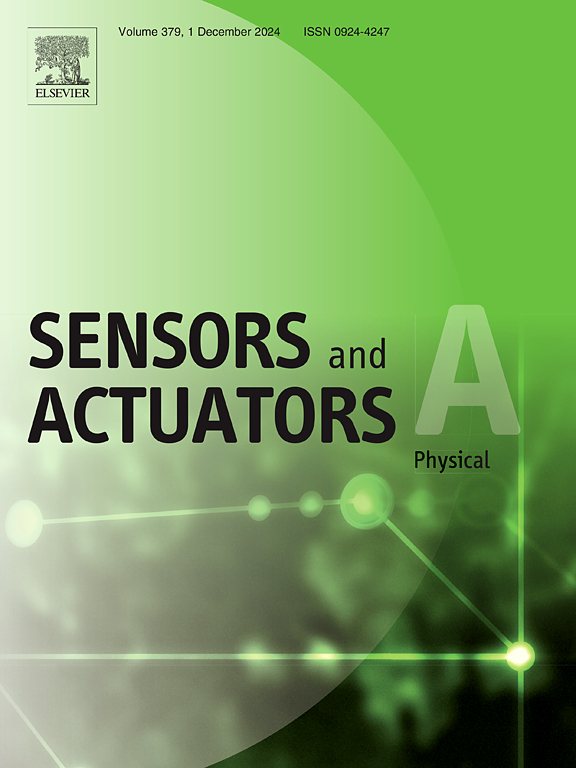Liquid-phase laser ablation synthesis of CsPbI3 nanorods for high responsivity photodetectors
IF 4.1
3区 工程技术
Q2 ENGINEERING, ELECTRICAL & ELECTRONIC
引用次数: 0
Abstract
We report the controllable synthesis of all-inorganic cesium lead iodide (CsPbI₃) nanorods (NRs) using pulsed laser ablation in liquid (PLAL), demonstrating a transformative approach for advancing optoelectronic device performance. By modulating laser fluence from 6.3 J/cm² to 9 J/cm², the aspect ratio of NRs increased from ∼1.3 to ∼4.0, accompanied by a quantum confinement-induced blue shift in photoluminescence from 424 nm to 400 nm. Structural analysis revealed a reduction in lattice strain by 28 % and a crystallite size enhancement from 30 nm to 55 nm at higher fluence, as evidenced by X-ray diffraction (XRD). Optoelectronic characterization of CsPbI₃/Si heterojunction photodetectors fabricated under optimized conditions (9 J/cm²) demonstrated a remarkable responsivity of 34 A/W, a detectivity of 6 × 10 ¹ ² Jones, and an external quantum efficiency (EQE) of 85 %, representing a 54 %, 50 %, and 98 % improvement, respectively, compared to devices synthesized at 6.3 J/cm². Measurements showed that high-fluence films responded more quickly (rise time 0.27 s, fall time 0.35 s), attributable to improved grain connectivity and a lower defect density. Elemental analysis confirmed a near-ideal Cs:Pb:I stoichiometry (1:1:3) with deviations below 2 % at optimal conditions, critical for ensuring high photoresponse stability. These results establish PLAL as a scalable method for engineering nanostructured perovskite materials with tailored properties, paving the way for high-sensitivity, high-performance photodetectors and other next-generation optoelectronic devices. The illuminated energy band diagram of CsPbI3/Si was constructed.
液相激光烧蚀合成用于高响应光电探测器的CsPbI3纳米棒
我们报道了利用脉冲激光烧蚀(PLAL)在液体中可控合成全无机碘化铯铅(CsPbI₃)纳米棒(NRs),展示了一种提高光电器件性能的变革性方法。通过将激光通量从6.3 J/cm²调制到9 J/cm²,NRs的宽高比从~ 1.3增加到~ 4.0,并伴有量子束缚诱导的光致发光蓝移,从424 nm到400 nm。x射线衍射(XRD)表明,在较高的影响下,晶格应变降低了28% %,晶粒尺寸从30 nm增大到55 nm。光电特性的CsPbI₃/硅异质结光电探测器捏造在优化条件下(9 J /厘米²)表现出显著的响应率34 a / W,探测能力6 ×10 ¹ ²琼斯,和外部量子效率(EQE) 85 %,代表54 % 50 %,和98年 %改进,分别,而设备合成6.3 J / cm²。测量结果表明,高通量薄膜的响应速度更快(上升时间0.27 s,下降时间0.35 s),这是由于改善了晶粒连通性和降低了缺陷密度。元素分析证实了接近理想的Cs:Pb:I化学计量(1:1:3),在最佳条件下偏差低于2 %,这对确保高光响应稳定性至关重要。这些结果奠定了PLAL作为一种可扩展的方法,用于工程纳米结构钙钛矿材料,具有定制的性能,为高灵敏度,高性能光电探测器和其他下一代光电器件铺平了道路。构造了CsPbI3/Si的发光能带图。
本文章由计算机程序翻译,如有差异,请以英文原文为准。
求助全文
约1分钟内获得全文
求助全文
来源期刊

Sensors and Actuators A-physical
工程技术-工程:电子与电气
CiteScore
8.10
自引率
6.50%
发文量
630
审稿时长
49 days
期刊介绍:
Sensors and Actuators A: Physical brings together multidisciplinary interests in one journal entirely devoted to disseminating information on all aspects of research and development of solid-state devices for transducing physical signals. Sensors and Actuators A: Physical regularly publishes original papers, letters to the Editors and from time to time invited review articles within the following device areas:
• Fundamentals and Physics, such as: classification of effects, physical effects, measurement theory, modelling of sensors, measurement standards, measurement errors, units and constants, time and frequency measurement. Modeling papers should bring new modeling techniques to the field and be supported by experimental results.
• Materials and their Processing, such as: piezoelectric materials, polymers, metal oxides, III-V and II-VI semiconductors, thick and thin films, optical glass fibres, amorphous, polycrystalline and monocrystalline silicon.
• Optoelectronic sensors, such as: photovoltaic diodes, photoconductors, photodiodes, phototransistors, positron-sensitive photodetectors, optoisolators, photodiode arrays, charge-coupled devices, light-emitting diodes, injection lasers and liquid-crystal displays.
• Mechanical sensors, such as: metallic, thin-film and semiconductor strain gauges, diffused silicon pressure sensors, silicon accelerometers, solid-state displacement transducers, piezo junction devices, piezoelectric field-effect transducers (PiFETs), tunnel-diode strain sensors, surface acoustic wave devices, silicon micromechanical switches, solid-state flow meters and electronic flow controllers.
Etc...
 求助内容:
求助内容: 应助结果提醒方式:
应助结果提醒方式:


